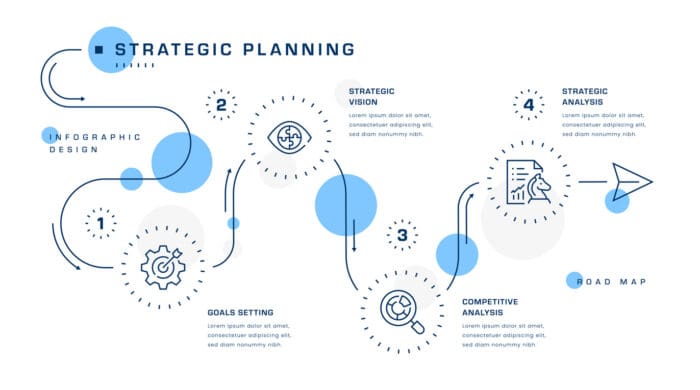Effective business strategy planning ensures long-term success. In this guide, you’ll learn to create a strategic plan aligned with your mission and vision. We will cover key elements like setting clear goals, assessing the market environment, involving stakeholders, measuring success, and adjusting your plan.
Key Takeaways
- Strategic planning is a comprehensive process that creates a roadmap for achieving long-term objectives by aligning daily operations with organizational goals.
- Critical elements of effective strategic planning include defining vision and mission statements, setting measurable objectives, and assessing internal and external business environments using tools like SWOT and PEST analysis.
- Successful implementation and measurement of a strategic plan require clarity in responsibilities, regular monitoring of KPIs, and stakeholder engagement to ensure alignment and adaptability in response to changing conditions.
Understanding Strategy Planning

Strategic planning involves creating a roadmap to achieve an organization’s long-term objectives. It extends beyond goal setting by examining current realities and future aspirations to define a clear vision. This strategic planning process aligns with the organization’s mission, ensuring every action contributes to broader goals.
Strategic planning focuses on long-term objectives and breaks them into actionable short-term goals, aligning daily operations with the company’s ambitions. It fosters a culture of objective decision-making based on data and analysis, helping to eliminate biases and make informed choices.
A well-executed strategic plan offers a competitive edge by anticipating market trends and conducting thorough internal analysis. Aligning the mission, vision, and goals contributes to organizational culture and creates a cohesive framework for a successful business strategy.
Key Elements of Strategic Planning

The foundation of any strategic plan lies in its vision and mission statements. A vision statement serves as a guiding star, illustrating the long-term goals and aspirations of the organization. It paints a picture of what success looks like and provides direction for selecting current and future actions. Complementing this, a mission statement explains how the organization plans to achieve its vision, clarifying the methods and approaches to be employed.
Setting specific and measurable objectives helps organizations assess progress toward their mission and vision. Objectives should be realistically achievable, balancing ambitious goals with practical realities and resources, ensuring plans are both inspirational and grounded.
A strategic plan, inspired by mission and vision statements, outlines actions to achieve goals. Checking the plan against market conditions and resources ensures strategies are both visionary and practical.
Assessing Your Business Environment
Assessing the business environment is critical for a successful strategy. It begins with an environmental scan to identify external factors. PEST analysis evaluates political, economic, social, and technological trends that could impact strategies, avoiding missed opportunities and threats.
Internal analysis is equally important. Tools like SWOT help businesses understand strengths, weaknesses, opportunities, and threats, guiding strategic decisions to leverage strengths and address weaknesses. Focusing solely on internal factors can skew strategies, leading to overestimated strengths and weaknesses.
Neglecting external factors and outdated data can mislead decisions and hinder innovation. Recognizing internal and external factors is essential for accurately assessing a business’s position and market challenges, allowing agility and responsiveness to changing conditions.
Setting Strategic Goals

After assessing the business environment, the next step is establishing a clear strategic direction. Strategic goals enhance efficiency by connecting daily tasks to the company’s vision, ensuring every action is purposeful and aligned with broader objectives.
Differentiating between strategic, tactical, and operational goals avoids misalignment and confusion. Strategic goals focus on long-term aspirations and break these into actionable steps. In contrast, operational goals handle day-to-day tasks, ensuring all levels work towards the same end.
Setting challenging yet attainable goals promotes innovation without demotivation. Transparency in goal setting fosters employee ownership and motivation. Metrics for success should include milestones and quantifiable performance measures, providing a clear picture of progress and areas for improvement.
Developing a Strategic Plan
Developing a strategic plan begins with defining the mission and vision, laying the foundation for all planning activities. Businesses should then collect and analyze information about operations and market conditions to ensure effective strategy formulation. This data-driven approach guides plan execution.
Yearly objectives should align with overall strategic goals, creating a cohesive plan that ties daily work to high-level business objectives. Tools like the balanced scorecard set strategic objectives across key areas, ensuring a comprehensive approach. The BCG matrix categorizes business units based on market growth and share, guiding resource allocation decisions and informing business strategies.
A flexible strategy document is crucial for adapting to changing market conditions. A high-level project roadmap visualizes the timeline of initiatives, creating a clear path for implementation. A work management platform can centralize the strategic plan, tying tasks to company goals and ensuring alignment.
Involving Stakeholders in the Planning Process
Engaging a variety of stakeholders enhances the likelihood of success for strategic initiatives. Effective engagement brings fresh perspectives, revealing gaps in existing plans and assumptions. Identifying different stakeholders, such as sponsors and end-users, ensures all relevant voices are heard.
Incorporating stakeholder feedback early in the planning process shapes effective strategies. Active participation ensures equitable representation and diverse input, leading to robust plans. Frequent communication and progress updates maintain team morale and keep stakeholders informed.
A common issue in strategic planning is a lack of ownership, which leads to disjointed execution. Visual documentation of goals and progress improves clarity and understanding among team members, ensuring alignment and commitment to the strategic plan.
Implementing Your Strategic Plan
Implementing a strategic plan requires clear communication and understanding of responsibilities. Assigning specific responsibilities enhances accountability and fosters transparency in project management. A well-defined action plan with clear objectives is crucial before strategy implementation.
Tactics encompass initiatives and projects essential for executing a strategic plan and achieving objectives. Regularly reviewing metrics during follow-up meetings ensures they provide helpful information for adjustments. KPIs, targets, and deadlines are essential for monitoring progress.
A dedicated strategic management team communicates, coordinates, and evaluates progress against goals. It is vital to stay aligned with the core strategy; tasks diverging from the plan should be deferred to maintain focus.
Measuring Success and Adjusting Strategies

Measuring the success of a strategic plan involves tracking key performance indicators (KPIs), which are essential for assessing progress and identifying areas for improvement. Assigning KPIs based on organizational goals ensures that metrics are relevant and aligned with objectives.
Regularly revising and adjusting strategic goals ensures their relevance amid changing conditions. Establishing a system for annual reviews and adjustments keeps the strategy dynamic and responsive to new information, making it an ongoing process.
Establish metrics to measure success and outline timelines to track progress effectively.
Tools and Resources for Strategic Planning
Having the right tools and resources is crucial for effective strategic planning. A strategic planning template can outline the plan and track progress, typically including vision and mission statements, competitive analyses, SWOT assessments, and relevant KPIs.
Strategic map templates visualize objectives and their interrelationships. The balanced scorecard helps set goals and assess performance beyond financial metrics. The OKR framework breaks down business goals into measurable objectives to enhance team alignment.
Gap analysis identifies discrepancies between current performance and desired outcomes. Feature market analysis assesses customer needs and competitor offerings to prioritize product features. Tools like Pareto and four corners analysis provide valuable insights for focused strategic actions.
Common Pitfalls in Strategic Planning
Despite best intentions, many organizations fail in strategic planning due to common pitfalls. Often, strategic plans are too broad and over-ambitious. Neglecting market analysis, research, or business intelligence leads to poorly informed strategies.
Relying on easy-to-use templates can promote shortsighted thinking and poorly executed strategies. Flexibility in strategy development is crucial for adapting to new information and changing circumstances. Competing priorities like quarterly targets and budget reconciliation can lead to a lack of commitment to the plan.
Poor targeting is a significant barrier to successfully executing a strategic plan. An appetite for simplicity should not override the need for thoroughness in strategy development. By knowing these pitfalls, organizations can better navigate the planning process and achieve desired outcomes.
Summary
Strategic planning is an ongoing process that requires careful consideration, clear communication, and continuous adjustments. By understanding the fundamentals of strategic planning, assessing the business environment, setting clear goals, involving stakeholders, and implementing the plan effectively, organizations can navigate the complexities of the business landscape and achieve long-term success.
In summary, strategic planning is not a one-time event but a dynamic process that evolves with the organization. By avoiding common pitfalls and leveraging the right tools and resources, businesses can develop and execute strategies that drive sustainable growth and competitive advantage.

Frequently Asked Questions
What is strategic planning?
Strategic planning is formulating a plan to achieve long-term objectives by ensuring that short-term goals align with the organization's vision and mission. This alignment is essential for organizational success.
How do vision and mission statements differ?
Vision statements articulate an organization's long-term aspirations, whereas mission statements detail the strategies and actions necessary to realize those aspirations.
Why is stakeholder involvement significant in strategic planning?
Stakeholder involvement is crucial in strategic planning. It brings diverse perspectives, uncovers gaps, and ensures that the plan aligns with the needs and expectations of all relevant parties. This inclusivity enhances the effectiveness and acceptance of strategic initiatives.
What tools are helpful for strategic planning?
Tools like strategic planning templates, balanced scorecards, OKR frameworks, and SWOT analyses can effectively support strategic planning. These tools will enhance your planning process and ensure better alignment with your goals.
What are common pitfalls in strategic planning?
One should avoid common pitfalls in strategic planning, such as creating overly broad plans, neglecting market analysis, relying excessively on templates, and not adapting to changing circumstances. These missteps can undermine the strategic plan's effectiveness and relevance.

Take Your Strategy Planning to the Next Level
Ready to build an effective strategy that drives your business's success? Our team can help you create a tailored plan that aligns with your goals and sets you apart from the competition.
Get Expert Strategy Advice
Looking for professional guidance on developing a winning business strategy?
👉 Schedule a Consultation
Explore More Strategy Insights
Dive deeper into strategic planning and other essential business tips.
👉 Read More Related Content
Have Questions? We’re Here to Help!
Reach out to us for answers and advice on your strategy planning needs.
👉 Contact Us Today
Mark Hope,
Partner
📧 mark.hope@asymmetric.pro
📞 (608) 410-4450
About the author
Mark A. Hope is the co-founder and Partner at Asymmetric Marketing, an innovative agency dedicated to creating high-performance sales and marketing systems, campaigns, processes, and strategies tailored for small businesses. With extensive experience spanning various industries, Asymmetric Marketing excels in delivering customized solutions that drive growth and success. If you’re looking to implement the strategies discussed in this article or need expert guidance on enhancing your marketing efforts, Mark is here to help. Contact him at 608-410-4450 or via email at mark.hope@asymmetric.pro.

